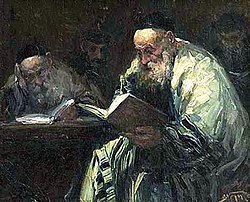
The Book of Esther, also known in Hebrew as "the Scroll", is a book in the third section of the Hebrew Bible. It is one of the Five Scrolls in the Hebrew Bible and later became part of the Christian Old Testament. The book relates the story of a Jewish woman in Persia, born as Hadassah but known as Esther, who becomes queen of Persia and thwarts a genocide of her people.

Esther, originally Hadassah, is the eponymous heroine of the Book of Esther in the Hebrew Bible. According to the biblical narrative, which is set in the Achaemenid Empire, the Persian king Ahasuerus falls in love with Esther and marries her. His grand vizier Haman is offended by Esther's cousin and guardian Mordecai because of his refusal to bow before him; bowing in front of another person was a prominent gesture of respect in Persian society, but deemed unacceptable by Mordecai, who believes that a Jew should only express submissiveness to God. Consequently, Haman plots to have all of Persia's Jews killed, and eventually convinces Ahasuerus to permit him to do so. However, Esther foils the plan by revealing and decrying Haman's plans to Ahasuerus, who then has Haman executed and grants permission to the Jews to take up arms against their enemies; Esther is hailed for her courage and for working to save the Jewish nation from eradication.
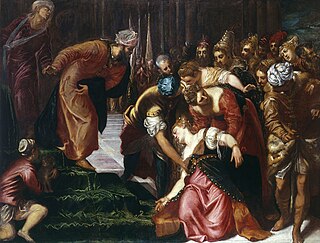
Ahasuerus is a name applied in the Hebrew Bible to three rulers of Ancient Persia and to a Babylonian official first appearing in the Tanach in the Book of Esther and later in the Christian Book of Tobit. It is a transliteration of either Xerxes I or Artaxerxes; both are names of multiple Achaemenid dynasty Persian kings.

Mordecai is one of the main personalities in the Book of Esther in the Hebrew Bible. He is described in Tanna Devei Eliyahu as being the son of Jair, of the tribe of Benjamin and member of the Sanhedrin. Mordecai was also the cousin and guardian of Esther, who became queen of Persia under the reign of Ahasuerus. Mordecai's loyalty and bravery are highlighted in the story as he helps Esther foil the plot of Haman, the king's Vizier, to exterminate the Jewish people. His story is celebrated in the Jewish holiday of Purim, which commemorates his victory. However, since the 1890s, some academics have suggested that Purim originated from a Babylonian or Persian myth or festival, noting the lack of overt religious elements in the story, with a hypothesis that “[The Book of] Esther [is] a historicized myth or ritual”.

Purim is a Jewish holiday that commemorates the saving of the Jewish people from annihilation at the hands of an official of the Achaemenid Empire named Haman, as it is recounted in the Book of Esther.

Vashti was a queen of Persia and the first wife of Persian king Ahasuerus in the Book of Esther, a book included within the Tanakh and the Old Testament which is read on the Jewish holiday of Purim. She was either executed or banished for her refusal to appear at the king's banquet to show her beauty as Ahasuerus wished, and was succeeded as queen by Esther, a Jew. That refusal might be better understood via the Jewish tradition that she was ordered to appear naked. In the Midrash, Vashti is described as wicked and vain; she is viewed as an independent-minded heroine in feminist theological interpretations of the Purim story.

Haman is the main antagonist in the Book of Esther, who according to the Hebrew Bible was an official in the court of the Persian empire under King Ahasuerus, commonly identified as Xerxes I but traditionally equated with Artaxerxes I or Artaxerxes II. As his epithet Agagite indicates, Haman was a descendant of Agag, the king of the Amalekites. Some commentators interpret this descent to be symbolic, due to his similar personality.

Esther is an oratorio by George Frideric Handel. It is generally acknowledged to be the first English oratorio. Handel set a libretto after the Old Testament drama by Jean Racine. The work was originally composed in 1718, but was heavily revised into a full oratorio in 1732.
According to the biblical book of Esther, Memucan was one of the seven vice-regents of the Persian King Ahasuerus.

Allusions in rabbinic literature to the Biblical character of Haman, the anti-Jewish villain of the Book of Esther, contain various expansions, elaborations and inferences beyond what is presented in the text of the Bible itself.
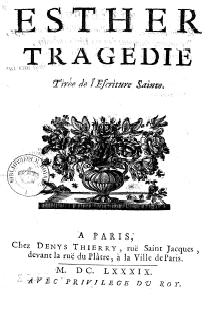
Esther is a play in three acts written in 1689 by the French dramatist, Jean Racine. It was premièred on January 26, 1689, performed by the pupils of the Maison royale de Saint-Louis, an educational institute for young girls of noble birth. The subject is taken from the biblical Book of Esther.
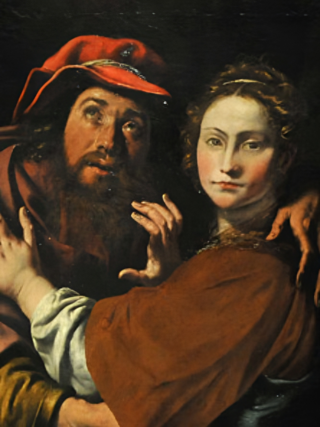
Rachel was a Biblical figure, the favorite of Jacob's two wives, and the mother of Joseph and Benjamin, two of the twelve progenitors of the tribes of Israel. Rachel's father was Laban. Her older sister was Leah, Jacob's first wife. Her aunt Rebecca was Jacob's mother.
Esther is an American opera in 3 acts composed by Hugo Weisgall, with a libretto by Charles Kondek. Esther was premiered by the New York City Opera in October 1993. The opera is about Esther's struggle as she becomes the queen of Persia, and her heroic triumph over the evil Prime Minister Haman and his plot of exterminating the Jews.

Esther, also known as The Bible: Esther, is a 1999 American-Italian-German television film based on the Book of Esther, directed by Raffaele Mertes and starring Louise Lombard as Queen Esther, F. Murray Abraham as Mordechai, Jürgen Prochnow as Haman, Thomas Kretschmann as King Achashverosh and Ornella Muti as Vashti.

One Night with the King is a 2006 American religious epic film produced by Matt Crouch and Laurie Crouch of Gener8Xion Entertainment, directed by Michael O. Sajbel, and starring Peter O'Toole, Tiffany Dupont, John Rhys-Davies, and Luke Goss.

The Book of Esther is a 2013 American biblical-drama film directed by David A. R. White and starring Jen Lilley as Esther. The film portrays a Jewish girl, Esther, who is chosen as the new queen consort to King Xerxes I of Persia and her efforts to stop evil Lord Haman's plot to exterminate the Jews. The film is loosely based on the biblical tale of the Book of Esther. It was released on June 11, 2013, in the United States as a direct-to-TV special.

Life of Esther or Scenes from the Story of Esther is the title of a series of six panel paintings by Sandro Botticelli and Filippino Lippi, showing scenes from the story of Esther and produced in the 1470s. They originally decorated the sides of a pair of cassoni or marriage chests, the two long panels on the fronts, and the smaller ones on the ends. They are now split between five museums in Europe and Canada.
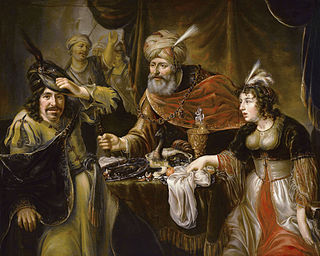
Esther 5 is the fifth chapter of the Book of Esther in the Hebrew Bible or the Old Testament of the Christian Bible, The author of the book is unknown and modern scholars have established that the final stage of the Hebrew text would have been formed by the second century BCE. Chapters 3 to 8 contain the nine scenes that form the complication in the book. This chapter records that Esther's risky behavior to appear uninvited before the king Ahasuerus is richly rewarded, because the king generously offers to give her whatever she wants, 'even to the half of my kingdom', but Esther cleverly asks for nothing more than an opportunity to entertain her husband and his chief officer, Haman. Both men were pleased at her hospitality, but when the king again offers her half the empire, this time she requests only a second banquet. While Haman was happy to have been entertained by the queen, he became intensely distressed when Mordecai once more refused to bow down before him. Haman's wife, Zeresh, advised him to erect a monumental gallows intended for Mordecai, and only then Haman felt happy again to look forward to Esther's second banquet.
Das Buch Esther is a German silent historical film from 1919, set in the time of biblical antiquity. The direction and script are by Uwe Jens Krafft and Ernst Reicher. Reicher and Stella Harf, who played the main roles, were married at the time.
The Targum Rishon, also known as the First Targum of Esther in the Hebrew, is an Aramaic translation (targum) and elaboration of the Book of Esther. Much less apocryphal material is used to embellish its account compared with Targum Sheni, and it is also significantly shorter, as Targum Sheni is two and a half times its length. Neither should be confused with another targum of Esther mentioned by tractate Megillah of the Talmud, which is an earlier but now lost text. Targum Rishon is dated approximately between 500 and 700, and is of Palestinian provenance. It postdates the Babylonian Talmud. One recent analysis, though the conclusion remains tentative, places both targums no later than the early seventh century and in Palestine, composed roughly in the same period; furthermore, it proposes that both derive from an earlier rabbinic text known as Esther Rabbati.
